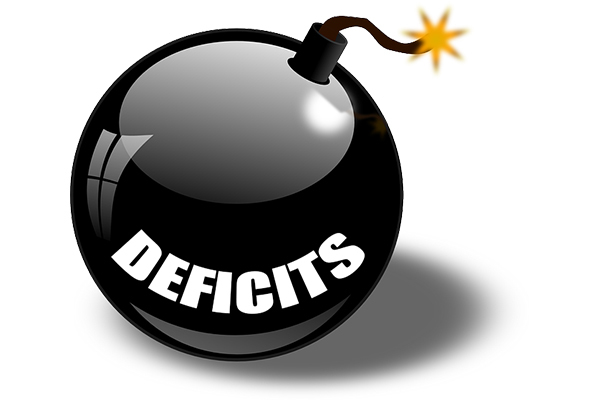A new report by the Congressional Budget Office predicts the nation’s debt and deficit will continue to grow over the next decade.
The Congressional Budget Office (CBO) report, “Budget and Economic Outlook: 2015 to 2025,” projects a brief slowdown in the rate of growth of the national debt over the next three years, followed by a continuation of previous deficit trends, with the annual federal deficit increasing by approximately 148 percent per year over the next 10 years.
By 2025 the federal deficit will exceed $1.088 trillion, or roughly $8,369 per U.S. household, CBO projects. In Fiscal Year 2014, the federal deficit was $483 billion, or about $4,192 per household.
Spending More and More
Increased subsidization of health care is a primary cause of the upcoming debt growth, Heritage Foundation budget expert Romina Boccia says.
“The major health care programs—Medicare, Medicaid, the Children’s Health Insurance Program, and Obamacare—are driving 32 percent of the increase in spending over the next decade, followed closely by the Social Security program at 28 percent, and interest on the debt at 24 percent,” she said.
‘A Spending Problem’
Raising taxes to compensate for the ballooning debt would only make problems worse, Boccia says.
“Tax increases take resources from the American people and place them in the hands of bureaucrats. The country has a spending problem, not a deficit problem,” she said.
Without major entitlement reform, she says, the problem will continue to balloon until it explodes.
“Without reforms, spending on interest on the debt, health care programs, and Social Security will reach unsustainable levels,” she said. “As a result, these spending levels will cause exploding deficits, even as tax revenues exceed their average historical level.”
Anthony Randazzo, director of economic research at the Reason Foundation, also identifies health care spending as the cause of the nation’s looming debt and deficit problems.
“CBO is projecting the ‘average exchange subsidy per subsidized enrollee’ will nearly double over the next decade,” Randazzo said.
Questions Report’s Assumptions
However, Randazzo notes, economic forecasts are only as good as the assumptions behind the models.
“For instance, their model has the drop in oil prices as a negative for the U.S. economy, where I would estimate that it winds up being a net positive,” he said. “On the other hand, they have unemployment falling while labor market participation is similarly declining over the next decade, which I would interpret as creating an increase in underemployment, and thus adding downward pressure to economic growth.”
Alexa Moutevelis Coombs ([email protected]) writes from Washington, DC.
Internet Info:
“Public Debt Overhangs: Advanced Economy Episodes since 1800,” Carmen M. Reinhart and Kenneth S. Rogoff, http://www.heartland.org/policy-documents/public-debt-overhangs-advanced-economy-episodes-1800/




